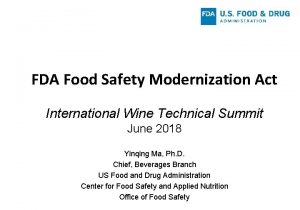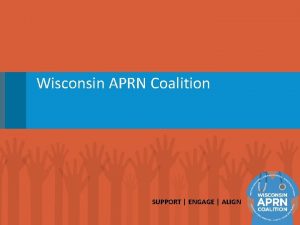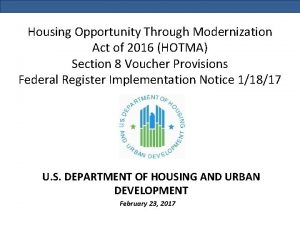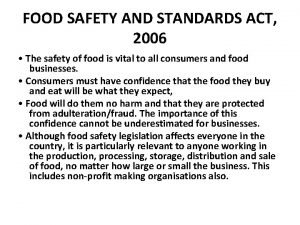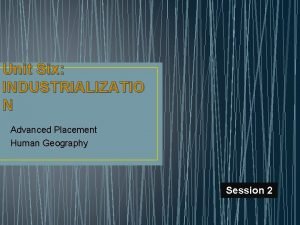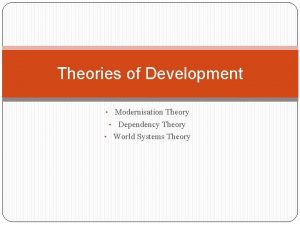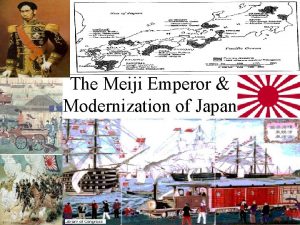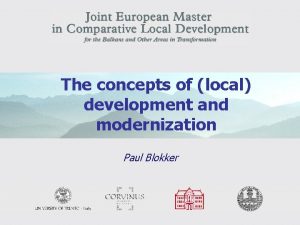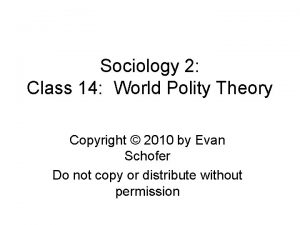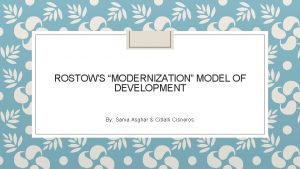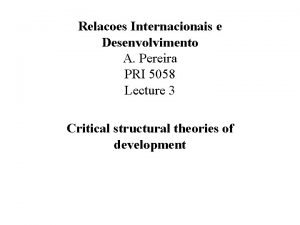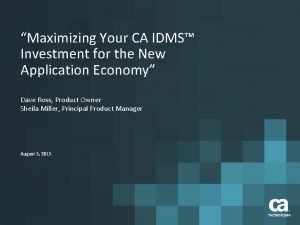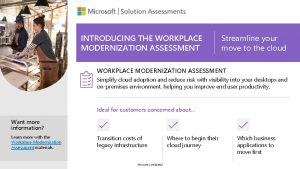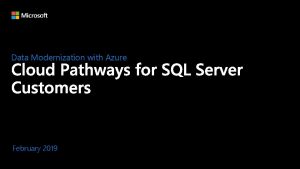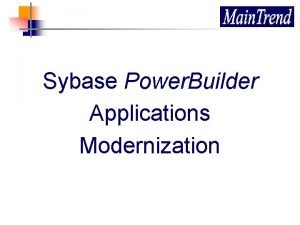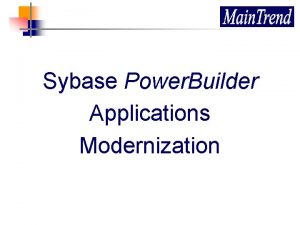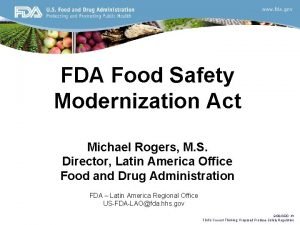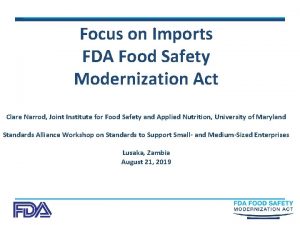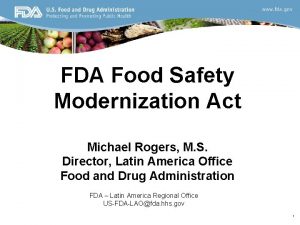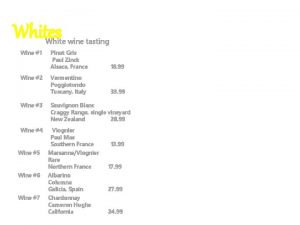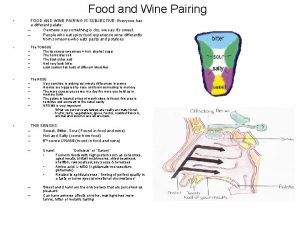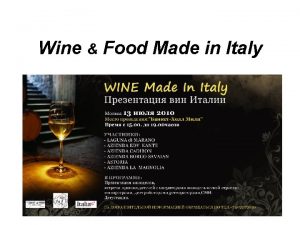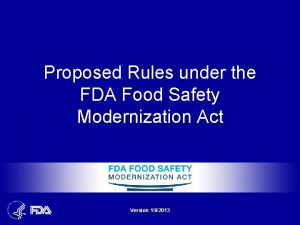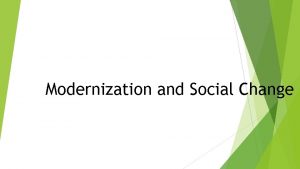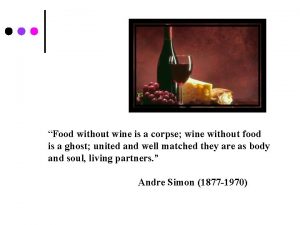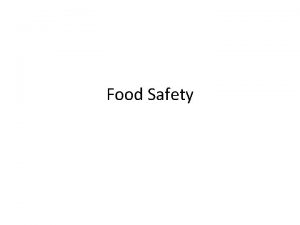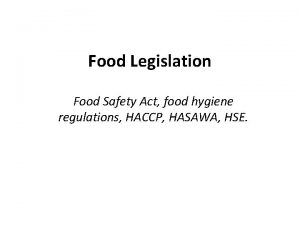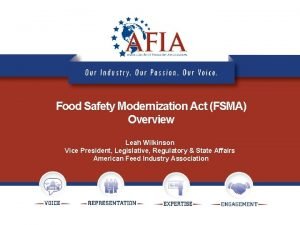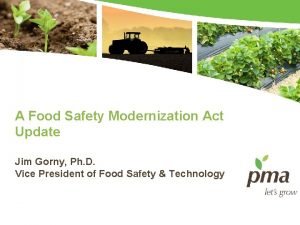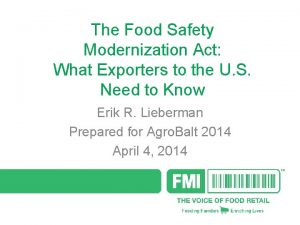FDA Food Safety Modernization Act International Wine Technical

























- Slides: 25

FDA Food Safety Modernization Act International Wine Technical Summit June 2018 Yinqing Ma, Ph. D. Chief, Beverages Branch US Food and Drug Administration Center for Food Safety and Applied Nutrition Office of Food Safety

FDA Food Safety Modernization Act 1. Food Safety Modernization Act signed January 2011 by President Obama 2. Listening sessions 3. FDA drafted proposed rules based on the new law, as well as input from public meetings and listening sessions 4. FDA published proposed rules for comment 5. Comments were considered and changes integrated into proposed rules 6. Final Rules were published 2

FSMA Main Themes Prevention Inspections, Compliance, and Response Enhanced Partnerships Import Safety 3

FSMA – Section 305 “Building Capacity of Foreign Governments with Respect to Food Safety” • Directs FDA to: …develop a comprehensive plan to expand the technical, scientific, and regulatory food safety capacity of foreign governments and their respective food industries, from which foods are exported to the United States. • FDA’s Capacity Building Plan – Element 4 Train foreign governments and food producers on US requirements for safe food https: //www. fda. gov/Food/Guidance. Regulation/FSMA/ucm 301708. htm 4

7 Foundational Final Rules 1. 2. 3. 4. 5. 6. 7. Preventive Controls for Human Food Preventive Controls for Animal Food Produce Safety Foreign Supplier Verification Program Accredited Third-Party Certification Sanitary Transportation Intentional Adulteration 5

21 CFR part 117 • Current Good Manufacturing Practice, Hazard Analysis, and Risk-Based Preventive Controls for Human Food (CGMP & PC rule) • Modernizes longstanding current good manufacturing practice (CGMP) requirements • Establishes new requirements for hazard analysis and risk-based preventive controls (HA/PC requirements) 6

21 CFR part 117 • Subpart A – General Provisions • Subpart B – Current Good Manufacturing Practice • Subpart C – Hazard Analysis and Risk-based Preventive Controls • Subpart D – Modified Requirements • Subpart E – Withdrawal of a Qualified Facility Exemption • Subpart F – Requirements Applying to Records that Must be Established and Maintained • Subpart G – Supply-chain Program 7

HA/PC Requirements • Apply to facilities that have to register with FDA – facility is engaged in the manufacturing/processing, packing, or holding of food for consumption in the United States. – Manufacturing/processing means making food from one or more ingredients, or synthesizing, preparing, treating, modifying or manipulating food, including food crops or ingredients. 8

Food Safety Plan • Contents – – – Hazard analysis Preventive controls (including supply-chain program) Procedures for monitoring implementation Corrective action procedures Verification procedures Recall plan • Records (the plan and its implementation) must be kept • Certain activities must be done or overseen by a “preventive controls qualified individual” (PCQI) 9

Certain exemptions (from subparts C and G) • Foods subject to Hazard Analysis & Critical Control Point (HACCP) regulations (i. e. , seafood and juice) • Dietary supplements • Alcoholic beverages • Food subject to low-acid canned food regulations (microbiological hazards only) 10

Alcoholic beverages • An alcoholic beverage is a “food” as described in 21 CFR 1. 227, which states in part, “Examples of food include: . . . beverages (including alcoholic beverages and bottled water)”. • A facility such as a winery that manufactures alcoholic beverages would have to register with FDA as a food facility (see 21 CFR Part 1, subpart H), unless it satisfies any of the criteria for entities that are not required to register (see 21 CFR 1. 226). 11

Alcoholic beverages • The CGMP & PC rule contains a partial exemption for certain food and alcohol at certain alcohol-related facilities (21 CFR 117. 5(i)). • The following two conditions must be met for alcoholic beverages at a facility to be exempt from subparts C and G of the rule (21 CFR 117. 5(i)(1)): – (i) Under the Federal Alcohol Administration Act (27 U. S. C. 201 et seq. ) or chapter 51 of subtitle E of the Internal Revenue Code of 1986 (26 U. S. C. 5001 et seq. ) the facility is required to obtain a permit from, register with, or obtain approval of a notice or application from the Secretary of the Treasury as a condition of doing business in the United States, or is a foreign facility of a type that would require such a permit, registration, or approval if it were a domestic facility; and – (ii) Under section 415 of the Federal Food, Drug, and Cosmetic Act the facility is required to register as a facility because it is engaged in manufacturing, processing, packing, or holding one or more alcoholic 12 beverages.

Alcoholic beverages • 21 CFR 117. 5(i)(2). • Subparts C and G do not apply to food that is not an alcoholic beverage at a facility described in 117. 5(i)(1), provided that: – Is in prepackaged form that prevents any direct human contact with such food; and – Constitutes not more than 5 percent of the overall sales of the facility, as determined by the Secretary of the Treasury 13

Examples of requirements that are not applicable if an alcoholic beverage facility is subject to the exemption: • Any requirements for Preventive Controls Qualified Individual (PCQI) for a winery? – A PCQI is only required when a facility must develop and implement a food safety plan. – If a facility is exempt from the requirements of Subparts C and G, such a facility would not need a PCQI. • Any requirements to comply with allergen control, sanitation control, and recall provisions under 21 CFR 117 for a winery? – Exemption of alcoholic beverage from subparts C and G is described in 117. 5(i)(1). – This exemption would apply to food allergen controls, sanitation controls, and the recall plan requirements of 21 CFR 117. 135. 14

Alcoholic beverages • Note that the exemption from 21 CFR 117. 5(i) is not from all subparts of the rule (21 CFR part 117). • The current good manufacturing practice (CGMP) requirements of 21 CFR part 117, subpart B, as well as the CGMP-related requirements of subpart A and the CGMPrelated records requirements of subpart F apply to alcoholic beverage facilities, such as wineries, that manufacture beverages for human consumption. • An alcoholic beverage facility, such as a winery, must ensure that its alcoholic beverage products are not adulterated under section 402 of the FD&C Act or misbranded under section 403 of the FD&C Act. 15

CGMP requirements • The CGMP requirements in 21 CFR part 117 (mostly in subpart B) generally align with the requirements of 21 CFR part 110, with the non-binding provisions in 21 CFR part 110 removed or made binding. • In addition, 21 CFR 117 subpart B addresses allergen cross-contact explicitly in the regulatory text. • Furthermore, training, which was recommended in 21 CFR part 110, is now mandated in 21 CFR 117 subpart A (associated record requirements are in subpart F). 16

CGMP training requirements • Each individual engaged in manufacturing, processing, packing, or holding food, including temporary and seasonal personnel (e. g. , contract laborers), must: – be a “qualified individual” (i. e. , have the education, training, experience, or a combination thereof, necessary to manufacture, process, pack, or hold clean and safe food as appropriate to the individual’s assigned duties [see 21 CFR 117. 4(b)(1)], and – Receive training in the principles of food hygiene and food safety, including the importance of employee health and personal hygiene, as appropriate to the food, the facility and the individual’s assigned duties [see 21 CFR 117. 4(b)(2)]. • Supervisory personnel must have the education, training, or experience (or a combination thereof) necessary to supervise the production of clean and safe food [see 21 CFR 117. 4(c)]. • Records that document training required by 21 CFR 117. 4(b)(2) must be established and maintained and are subject to subpart F of the CGMP & PC rule [see 21 CFR 117. 4(d)]. 17

CGMP & PC FAQ • Question: What does this final rule specifically require human food facilities to do when providing a by-product for use as animal food? • Answer: Processors already implementing human food safety requirements, such as brewers, would not need to implement additional preventive controls or Current Good Manufacturing Practice (CGMP) regulations when supplying a by-product (e. g. , wet spent grains, fruit or vegetable peels, liquid whey) for animal food, except to prevent physical and chemical contamination when holding and distributing the by-product. This regulation applies to human food facilities that both donate or sell a by-product for use in animal food. Labeling that identifies the by-product by the common or usual name must be affixed to or accompany human food byproducts for use as animal food when distributed. https: //www. fda. gov/Food/Guidance. Regulation/FSMA/ucm 247559. htm#PC_Rules (PC 19) 18

• Answer continued: Further processing a by-product for use as animal food (e. g. , drying, pelleting, heat-treatment) would require compliance with CGMPs to ensure the animal food’s safety and to make sure that the processing does not introduce hazards to the animal food. The company can choose to follow either the human food or animal food CGMPs when further processing the byproduct. In addition, unless they are a qualified facility or otherwise exempt from subpart C (hazard analysis and preventive controls) the facility would need to assess its processing and determine whethere any hazards that would require a preventive control. A facility that appropriately determines through its hazard analysis that there are no hazards requiring a preventive control would document such a determination in its hazard analysis but would not need to establish preventive controls. https: //www. fda. gov/Food/Guidance. Regulation/FSMA/ucm 247559. htm#PC_Rules (PC 19) Also see 21 CFR 117. 95 19

7 Foundational Final Rules 1. 2. 3. 4. 5. 6. 7. Preventive Controls for Human Food Preventive Controls for Animal Food Produce Safety Foreign Supplier Verification Program Accredited Third-Party Certification Sanitary Transportation Intentional Adulteration 20

Purpose of FSVP • Provide adequate assurances that foreign supplier is producing food in compliance with processes and procedures providing same level of public health protection as those required under sec. 418 or 419 (if applicable) • Assurances that food is produced in compliance with secs. 402 and 403(w) 21

Exemptions • Alcoholic beverages are exempt if they are imported from a foreign supplier that is a facility that meets two conditions described in 21 CFR 1. 501(e)(1) • Exemption for food that is not an alcoholic beverage imported from foreign suppliers described in 1. 501(e)(1) that is in prepackaged form preventing any direct human contact with the food, when such food constitutes not more than 5 percent of the overall sales of the facility [21 CFR 1. 501(e)(2)] • Exemption for food used in the production of alcoholic beverages (e. g. , hops, grains, grapes) when certain conditions are met [21 CFR 1. 501(e)(3)] 22

FSMA Technical Assistance Networks FDA Technical Assistance Network (TAN), access the following link – https: //www. fda. gov/Food/Guidance. Regulation/FSMA/ucm 459719. htm FSMA Technical Assistance Network (TAN) Inquiries Report https: //www. fda. gov/Food/Guidance. Regulation/FSMA/ucm 498163. htm 23 23

Lead in wine data call • Codex Committee on Contaminants in Foods (CCCF) • Electronic Working Group (EWG) to conduct review of maximum levels (MLs) for lead in wine for consideration by CCCF 13 in 2019. • New data covering approximately the last 10 years • Submit to WHO through the GEMS database by October 1, 2018 • http: //www. who. int/foodsafety/Lead_in_food_comm odities_2018. pdf? ua=1 24

 Fda technical assistance network
Fda technical assistance network Wisconsin aprn modernization act
Wisconsin aprn modernization act Housing opportunity through modernization act of 2016
Housing opportunity through modernization act of 2016 Financial services modernization act of 1999 definition
Financial services modernization act of 1999 definition International wine associates
International wine associates Food safety 2006
Food safety 2006 Control measures for physical hazards
Control measures for physical hazards Macbeth act 2 summary
Macbeth act 2 summary Unit 2 food food food
Unit 2 food food food Eltonian pyramid
Eltonian pyramid Modernization model ap human geography
Modernization model ap human geography Wallerstein's world systems theory
Wallerstein's world systems theory Modernization in japan
Modernization in japan Conclusion on modernization
Conclusion on modernization Modernization theory
Modernization theory 5 stages of rostow's model
5 stages of rostow's model Rrrlf library legislation
Rrrlf library legislation Modernization theory vs dependency theory
Modernization theory vs dependency theory Criticism of dependency theory
Criticism of dependency theory Modernization in japan
Modernization in japan Idms modernization
Idms modernization Workplace modernization assessment
Workplace modernization assessment Modernization and globalization
Modernization and globalization Data modernization to azure
Data modernization to azure Powerbuilder modernization
Powerbuilder modernization Powerbuilder modernization
Powerbuilder modernization
